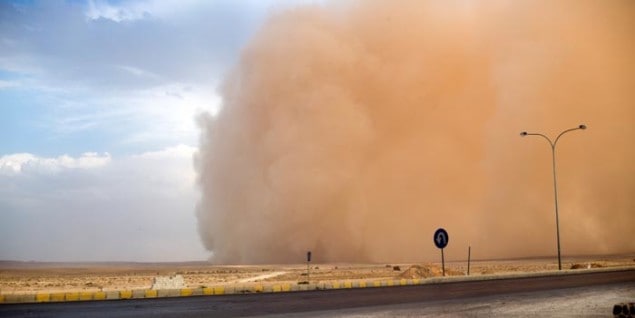
The colliding of whipped-up grains of sand increases the strength of sandstorms, according to researchers from Brazil, China and Switzerland. Bouncing along above a moving bed of grains, collisions between particles in mid-air can propel them to greater heights – increasing the overall storm flux. These transport processes are vital to sandstorms and similar phenomena, which act to reshape a variety of geological landscapes.
Moving particles in a sandstorm can be grouped into three categories: creepers, leapers and saltons. Creepers are sand grains that remain at ground level, while both leapers and saltons are flung up into the air. The difference in the latter type of grain comes in the height that they can achieve. Saltons gain enough altitude that their impact velocity on landing – the so-called splash – sends other saltons up into the air. Together, these movements form saltation, the main aeolian or wind-based transport process.
Modelling flows
The role of mid-air collisions in such particle transport has long been debated, with the expectation that collisions between grains would cause particle movement to suffer an overall reduction. By creating 3D models of sandstorms, however – both with and without collisions – the researchers discovered that this is not, in fact, the case.
“Surprisingly, we found an enormous enhancement of mass transport by the wind in the presence of mid-air collisions, compared with the case when such collisions are switched off,” explains Nuno Araújo, one of the researchers at the Eidgenössische Technische Hochschule Zürich.
Counterintuitive findings
Unlike previous theories – which argued that saltons could only be formed during a splash – the team’s model revealed that leapers can become saltons through a series of mid-air collisions that gradually increase their altitude. The higher the particles go – as well as the longer they can stay in the air – the greater the acceleration from the wind, which increases the likelihood of saltation formation.
This was not the only counterintuitive finding. The team also observed that the storm flux – a measurement of strength based on the number of particles moving through a given area – actually increased when the sand particles were modelled to lose energy when colliding, compared with correspondingly simulated elastic collisions. This is because inelastic collisions acted to align the exit directions of the interacting grains – thereby increasing the flux in the direction of the wind.
The results of this simulation also help make it clear how sandstorms get going in the first place. As the wind grows stronger, grains are slowly dragged along the surface of the sand bed. “Because of irregularities in the surface profile, some particles will hop, eventually producing small splashes,” Araújo explains. Through this process, and with a high enough wind velocity, such splashes can create sufficient leapers to ultimately begin saltation. In fact, when the team modelled storms without mid-air collisions, all the aerial particles were seen to be leapers.
Whipping up a storm
Previous studies of interactions within sandstorms were hindered by having insufficient computing power to run such detailed collision models. Araújo and his colleagues were able to circumvent this issue by optimizing their simulation and using a logarithmic velocity profile to simplify the calculation of the turbulent air motion.
“[This] study gives us a fresh, physicist’s perspective on the concept of saltation – which is the key mechanism for the movement of sand,” comments Tom Gill, a geologist at the University of Texas-El Paso who was not involved in the study. “Since saltation is also the key to the genesis of dust storms, the new work could also improve the modelling and parameterization of the effect of dust aerosols on the global environment and climate system.”
“An interesting follow up would be to experimentally observe the role of mid-air collisions,” says Araújo. While it would not be possible to “switch off” collisions in real life, it would be possible to experimentally vary the restitution coefficient – the ratio of the relative velocities of the colliding particles – within certain limits. Other possible future work that the team proposes includes studies factoring in the aerodynamic lift of the particles, fluctuations in the turbulent wind speed or electrostatic interaction between the particles, or models that assess the role of saltation in different conditions, such as a terrestrial desert, submarine or Martian environment.
The study is reported in Physical Review Letters.



